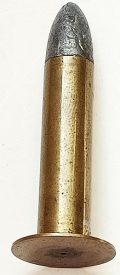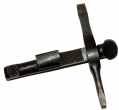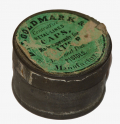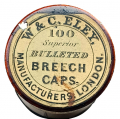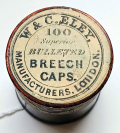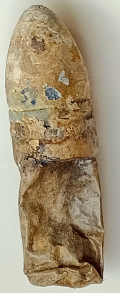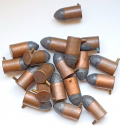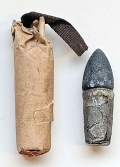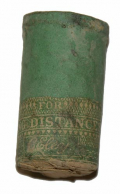site search
online catalog
Firearms
Showing 101 to 150 out of 256
“EXTREMELY RARE” SILVERED BRASS FRAME ALLEN AND WHEELOCK DROP-BREECH RIMFIRE RIFLE
Also known as the Allen Drop Breech, these breech-loading rimfire rifles were produced in limited numbers at Worcester, MA, from 1860 to 1871. Flayderman estimates them at 1,500 to 2,000 all told, but… (172-6030). Learn More »
CIVIL WAR SMITH CAVALRY CARBINE #5941
This Smith carbine, complete and all original, rates very good or near fine for overall condition with lots of original finish, good markings, strong color to the metal and wood showing a little… (172-6029). Learn More »
CONNECTICUT ARMS & MANUFACTURING CO. HAMMOND .44 RIMFIRE “BULLDOG” DERRINGER, CA. 1865-1868
This single-shot pistol is in very good condition, with clear markings and original blued barrel and casehardening on the frame. This is their standard production with 4” long barrel,… (490-7031). Learn More »
COLT LICENSED MINIATURE COLT BUNTLINE REVOLVER
Excellent condition, just about new-in-box miniature Colt Buntline. This has a case-hardened frame, blued barrel, and walnut grips, and is fitted with a folding rear sight on top of the flat frame.… (490-6814). Learn More »
ANSON MILLS PATENT CARTRIDGE BELT FOR THE .45-70
This H-shaped, stamped belt plate was adopted by the U.S. Army in 1886 and used on what is sometimes called the “loose-loop” belt, which has woven cartridge loops. This clean blue belt and brass… (1216-219). Learn More »
$295.00
ON HOLD
P1853 ENFIELD RIFLE MUSKET, DATED 1862, CONFEDERATE “CAPTURED, CLEANED, AND REPAIRED”
This is an English Pattern 1853 rifle musket that was imported into the country and used during the Civil War. Likely imported into the North and then “captured or collected” by Confederate… (490-6966). Learn More »
VERY PRETTY YORK COUNTY POWDER HORN
This a small, very pretty York County powder horn in about excellent condition, with nicely turned spout matching the rich brown color of the upper portion of the horn that smoothly transitions into… (490-6906). Learn More »
YORK COUNTY SCREW TIP POWDER HORN
This is a York County style powder horn made with a screw tip that is now missing, but with the upper portion of the spout clearly showing remnants of the threads that secured it. The form is… (490-6905). Learn More »
ALL-METAL RING TRIGGER PERCUSSION DERINGER
These small, unmarked, all-metal single action and singe-shot percussion pistols are the product of Bacon and Company of Norwich, CT, and manufactured in very small numbers from about 1852 to 1858, by… (490-7034). Learn More »
EARLY YORK COUNTY POWDER HORN
This is an early, classically York County style powder horn with two incised lines running around the top edge of the lathe-turned, convex base plug mirroring the two parallel incised lines along the… (490-6904). Learn More »
.35 CALIBER MAYNARD CARTRIDGE WITH COPPER RIVETED DISK
Dr. Edward Maynard held patent #22,565 dated January 11, 1859. By this patent, cartridge cases for the Maynard carbine were made of drawn brass to form a tube with a closed end. A brass disk was… (1212-186). Learn More »
BRITISH SERGEANTS’ WRENCH FOR SNIDER RIFLES
This is the combination tool for Snider-Enfield rifles. This style would have been made after September of 1866 when the Snider conversion of Enfield rifles was adopted. This is the usual British… (2024-503). Learn More »
NEW YORK CONTRACT REMINGTON ROLLING BLOCK WITH RACK NUMBERS
In the search for new metallic cartridge arms after the Civil War the U.S. government went with the trapdoor system, but New York went with the Remington rolling block, which was popular elsewhere in… (172-5976). Learn More »
RARE HANOVERIAN TIGE-RIFLE BULLET MOLD
This is a two-piece, scissor-type bullet mold made of brass. The two halves are held together with an iron pin. One arm is marked with a “2”. The mold measures 7.25” long overall. Brass exhibits… (1211-256). Learn More »
SPANISH AMERICAN WAR SHELL CASING FROM SALUTE FOR COL. C.H. WIKOFF, HIGHEST RANKING US OFFICER KILLED IN ACTION IN THE SPANISH AMERICAN WAR - SAN JUAN HILL
This fired brass shell casing was kept as a memento from the funeral of the highest-ranking U.S. officer killed in action in the Spanish-American War and comes with a period pencil note reading:… (1240-14). Learn More »
VERY NICE “DERRINGER” SINGLE SHOT PISTOL
The term “derringer” became a generic misspelling during the reporting of the Lincoln assassination, which was committed with a concealed Philadelphia Deringer. Many copies of the original… (172-6009). Learn More »
CONFEDERATE “CAPTURED AND COLLECTED” 5TH MODEL BURNSIDE CARBINE
Confederate “Captured and Collected” 5th Model Burnside Carbine. .54 cal. percussion single shot cavalry weapon produced by the Burnside Rifle Co. in Providence, Rhode Island. General Ambrose… (490-7021). Learn More »
RARE REMINGTON ELLIOTT US NAVY CARTRIDGE CONVERSION, ENGRAVED
This is a rare Remington, one of just 1,020 Remington percussion Navy revolvers altered to .38 caliber centerfire for the government by Remington in 1875. This is to be distinguished from five or six… (431-67). Learn More »
P.S. JUSTICE RIFLE MUSKET
This a very good example of the .69 caliber rifle musket made in Philadelphia by P.S. Justice at the beginning of the Civil War. The mounts are brass: nose cap, three convex, clamping barrel bands,… (1179-086). Learn More »
KITTREDGE MARKED FRANK WESSON DOUBLE-TRIGGER .44 CARBINE #4328
The Wesson is a scarce military carbine, made in .44 rimfire and sold mainly through gun dealers Kittredge and Company, of Cincinnati, to Ohio, Indiana, Kentucky, Kansas and Missouri for issue to… (1219-36). Learn More »
SCARCE EARLY WAR .44 CALIBER JOHNSTON & DOW CARTRIDGE
This is a .44 caliber revolver cartridge by Johnston & Dow of New York in excellent condition. Johnston & Dow received patent #33,393, #34,061, and #35,687 dated October 1, 1861, January 7,… (2024-1287). Learn More »
LARGE TWO-SIDED, 26-CAVITY IRON RIFLE BALL MOLD
Very large iron hinge-type mold to cast 26 lead round balls. Twelve cavities on top and twelve on the bottom. Each side is complete with its own funnel/sprue cutter. Cavities measure approximately… (236-1007). Learn More »
GOLDMARK PERCUSSION CAP TIN FOR COLT BELT AND POCKET PISTOLS
Plain unfinished tin with label; measures approximately 1” tall x 1.5” in diameter. The body of the container has very nice tin finish with no rust. Lid has green paper label that reads “D [_]… (490-6899). Learn More »
RARE .71 CALIBER IRON MUSKET BALL MOLD
Iron scissor-type mold to cast a lead round ball for muskets. Single cavity mold with spout on top and a sprue cutter in handle. Cavity measures approximately 0.695”. The number “13” is… (236-1002). Learn More »
DOUBLE-ACTION STARR .44 REVOLVER
This is a double-action Starr revolver in good condition that was likely for the civilian market. It is all original and had at some point been nickel plated; much of that plating is now worn off. The… (2022-2435). Learn More »
SMITH & WESSON NO. 2 ARMY REVOLVER
This is a Smith & Wesson, No. 2, Old Model Army Revolver. It is a .32 caliber, six-shot revolver with a 6” octagonal barrel and rosewood handles. Post-Civil War serial number of 46822.… (490-6867). Learn More »
$1,195.00
SOLD
SCARCE LEMAN MILITIA RIFLE
This is a very good example of a scarce rifle. Henry E. Leman made just 300 or so rifles of this pattern, including some variations. This is all original and complete with ramrod, sights, bands,… (490-6825). Learn More »
SHARPS AND HANKINS NAVY CARBINE
This is a good example of the single-shot, breech-loading .52 Caliber rimfire Sharps and Hankins Navy Carbine, also known as the Second Model or Model 1862, complete, all original, and showing some… (1224-01). Learn More »
US NAVY HOLSTER FOR 1895 DOUBLE ACTION COLT
This holster pattern was adopted by the Navy in 1889 for the new .38 Caliber double-action revolvers ordered that year, most of which were returned to Colt for alteration to the Model 1895 cylinder… (431-72). Learn More »
HOLSTER FOR M1861 COLT NAVY OR M1860 ARMY
This is a military non-regulation holster, unmarked, and typical of those purchased privately by officers or making their way into service by way of early war state troops and in the case of… (431-73). Learn More »
ADJUSTABLE BRASS POWDER MEASURE
This is an adjustable powder measure about 3 ½ inches long overall, made of brass, fitted with a small steel heart-shaped or winged thumbscrew at the bottom to adjust the interior rod fitted with a… (2024-160). Learn More »
VERY NICE CONDITION EARLY CIVIL WAR U.S. CAVALRY HOLSTER
This is a very good condition early-war holster for a .36 caliber revolver with full military flap, wide belt loop secured by stitching and three rivets, toe plug, and sewn latch tab. The stitching is… (286-1332). Learn More »
$695.00
ON HOLD
COLT MODEL 1877 DOUBLE ACTION .38 CAL. LONG BARREL LIGHTNING REVOLVER
Lots of original blue and some case colors with immaculate checkered hard rubber grips with the rampant colt at top on either side, about excellent condition. Long barrel version with ejector. Barrel… (490-5575). Learn More »
VERY RARE FULL TIN OF “BULLETED BREECH CAPS” BY W. & C. ELEY, LONDON
Offered here is a very fine condition japanned tin filled with 100 “bulleted breech caps.” A printed paper label on the lid reads, “100 Superior BULLETED BREECH CAPS. / W. & C. ELEY,… (2024-125). Learn More »
VERY RARE FULL TIN OF “BULLETED BREECH CAPS” BY W. & C. ELEY, LONDON
Offered here is a very fine condition japanned tin filled with 100 “bulleted breech caps.” A printed paper label on the lid reads, “100 Superior BULLETED BREECH CAPS. / W. & C. ELEY,… (2024-124). Learn More »
SCARCE J. HENRY & SON “SABER RIFLE” PENNSYLVANIA MILITIA AND EARLY WAR VOLUNTEERS, ILLUSTRATED IN DRILL MANUALS
These scarce, attractive and rather unique looking .58 caliber rifles made by J. Henry & Son have 35-inch octagon-to-round browned barrels, long-range rear sights and brass mounts encompassing the… (1193-24). Learn More »
"DUG" .58 CALIBER RIFLE MUSKET CARTRIDGE BY JOHNSON & DOW
Johnson & Dow received patents #33,393, #34,061, and #35,687 dated October 1, 1861, January 7, and June 24, 1862 for their cartridges. Using paper or fabric that was treated to make it… (236-944). Learn More »
.35 CALIBER MAYNARD CARTRIDGE
Dr. Edward Maynard held patent #22,565 dated January 11, 1859. By this patent, cartridge cases for the Maynard carbine were made of drawn brass to form a tube with a closed end. A brass disk was… (236-942). Learn More »
$90.00
ON HOLD
YORK COUNTY POWDER HORN
An elegant powder horn. From the size, a priming horn (approx 8" in length). Pleasing cream colored body shading to a greenish brown at the spout. The base is convex, lathe turned to produce incised… (480-354). Learn More »
12MM PINFIRE CARTRIDGE BY CHARLES FUSNOT
These are cartridges for the Lefaucheux revolver. This is the “short” pinfire cartridge; with lead bullet seated into a copper case with a stout pin protruding from the bottom edge. This features… (M19951). Learn More »
.442 WESTLEY RICHARDS “MONKEY TAIL” CARTRIDGE
This specimen is a very nice regulation paper wrapped skin cartridge for the British “Monkey Tail” rifles. This one is wrapped in tan paper. Cloth tear strip sticking out of the bottom end. Very… (1212-40). Learn More »
.442 WESTLEY RICHARDS “MONKEY TAIL” CARTRIDGE – BLUE PAPER
This specimen is a very nice paper wrapped skin cartridge for the British “Monkey Tail” rifles. This one is unusual as it is wrapped in blue paper (typically tan paper). Cloth tear strip sticking… (1212-54). Learn More »
REPRODUCTION .44 REMINGTON BY PIETTA WITH SPARE CYLINDER
Revolver has an 8.00 inch octagon barrel and a six-shot cylinder. Barrel, loading lever, cylinder and frame are all finished bright. All nipples are present on the cylinder. Hammer is also bright.… (922-30). Learn More »
BURNSIDE 5TH MODEL CARBINE, CONFEDERATE “CLEANED & REPAIRED”
This is the Burnside single shot percussion carbine, Model 1864, aka "5th model". It is a .54 caliber carbine manufactured by the Burnside Rifle Co., in Providence, Rhode Island. General Ambrose… (362-1163). Learn More »
EARLY BIRD-SHOT CARTRIDGE FOR 16-GAUGE SHOTGUN
Offered here is an early and interesting shot cartridge. 16-gauge cartridge with powder and shot contained in an outer paper wrapper. Cloth tear strips provide access to the cartridge. An orange label… (1212-138). Learn More »
US MODEL 1840 POMEROY CONTRACT MUSKET RIFLED AND SIGHTED
The US Model 1840 musket is complicated in nomenclature and production details. Initially designated the Model 1835, it was finally designated the 1840 and collectors occasionally call it the Model… (490-4171). Learn More »
SCARCE .36 CALIBER TINFOIL CARTRIDGE BY ELEY, LONDON
This is a very rare cartridge dating to before the Civil War. Made by Eley Brothers in London, this is a .36 caliber pistol cartridge with a tinfoil powder case. The cartridge was then packed in a… (1212-101). Learn More »
US WORLD WAR TWO M-1A1 PARATROOPER CARBINE SCABBARD
Scabbard was designed solely for the M-1A1 folding stock carbine. Made of OD Green canvas the scabbard was slightly padded with a flap at top that was fastened by two lift-dot fasteners. The rear has… (1216-21). Learn More »
LEATHER HOLSTER WITH VERBAL ID TO 17TH & 56TH NORTH CAROLINA CAPTAIN
Small black leather holster made for a small model pistol like a Colt pocket or Bacon revolver. Leather is very thin but in good supple condition. Outer flap has a 5.00 inch long strap sewn to the… (1179-533). Learn More »
VERY NICE ELEY’S WIRE SHOT
A colorful paper container with printed advertising and labels. Round label on the end reads, “ELEY’S / Improved Patent Wire Cartridge / No. 1”. Contains a wire “basket” filled with shot.… (1219-09). Learn More »
Showing 101 to 150 out of 256
Most Popular
Historical Firearms Stolen From The National Civil War Museum In Harrisburg, Pa »
Theft From Gravesite Of Gen. John Reynolds »
Selection Of Unframed Prints By Don Troiani »
Fine Condition Brass Infantry Bugle Insignia »
British Imported, Confederate Used Bayonet »
Scarce New Model 1865 Sharps Still In Percussion Near Factory New »
featured item
JULY 1863 LETTER BY FAMED COL. JOSHUA LAWRENCE CHAMBERLAIN OF THE 20TH MAINE
This letter comes from the hand of famed Colonel Joshua Lawrence Chamberlain of the 20th Maine and is written to his wife from his shelter tent in the Shenandoah Valley near Front Royal. Dated July 24th 1863, Col. Chamberlain details the fight of… (557-250). Learn More »













